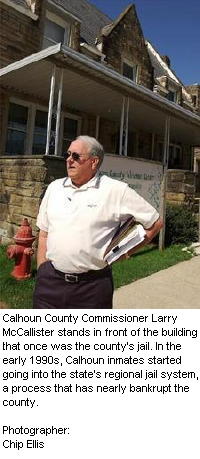 Jail Costs Overwhelm Counties
Jail Costs Overwhelm Counties
Higher Daily Rates Hurting Budgets
By Charles Shumaker Staff Writer
Sunday Gazette Mail
sundaygazettemail.com
GRANTSVILLE â In tiny Calhoun County, Commissioner Larry McCallister (right) knows what the next arrest could mean.
If it's a felony, and the person can't post bond, the county could be on the brink of bankruptcy. That is how serious the county's finances have been hurt by regional jail costs.
There have been layoffs. Four people have lost their jobs to help deal with the county's money problems, McCallister said.
Meanwhile, county leaders have sold property and reassessed the county's property to help increase income.
The cost of housing two murder suspects still awaiting a Calhoun County trial has done its part to run up the county's jail bill.
"You've got to sacrifice employees to pay room and board for prisoners," McCallister said. "That just doesn't sit well with me."
Calhoun is in the same position as many West Virginia counties.
Even the state's largest counties are struggling. Although their budget problems may not be solely based on regional jail costs, that has been the most popular target. Cabell County officials, for example, have refused to pay their growing jail debt. Kanawha and Putnam county officials are hoping a day reporting system for nonviolent adult offenders will save them a lot of money.
Steve Canterbury, the state Regional Jail Authority director, has heard from all of them. He said he is aware counties are struggling.
He was criticized in 2004 when he raised counties' per diem rates by $3.50 to $48.50 to cover rising health-care costs for inmates.
"It's just easy to point our way," Canterbury said. "The problem is that counties are seeing increases in all other aspects, like gasoline and employee pay or health care. Those are realities. It costs more now to keep the park up and to run the [police] cruisers. Everything has gotten more expensive, including running jails."
While some county administrators say they are better off with regional jails, and the accompanying bills, others loath paying them and fall behind.
'We had to do something'
In the early 1990s, Calhoun officials closed their jail and began shipping prisoners to the Central Regional Jail in Flatwoods. McCallister wasn't on the commission then, but looking back, he said he knows that it was something that had to be done.
He says that even though his county hasn't been able to pay its jail bill since January. Calhoun owes more than $50,000 and pays a couple of thousand during the months that it can.
Once this year, McCallister said, the county held county officials' paychecks a few days to cover outstanding bills.
But Calhoun County's jail, like 36 others at the time it joined the regional jail system, was facing federal oversight because of the deteriorating conditions.
In Putnam County, jail costs are expected to cost almost $450,000 more this fiscal year than they did during the last fiscal year. By June 30, when the current fiscal year ends, Putnam officials expect to have paid almost $1.15 million in jail costs since July 1, 2004, according to Putnam County Administrator Brian Donat.
Putnam County Commissioner Jim Caruthers knew that his county had to enter the regional jail system. In the late 1990s, Putnam leaders actually sought out the regional jail system as a money saver. Lawsuits over jail conditions, inmate medical costs and a severely overcrowded and deteriorating jail were all fast becoming budget busters, he said.
"We asked to get into the system early because we were at a crossroad," he recalled of the decision to send Putnam inmates to the South Central Regional Jail in Charleston.
"We really needed to do something. It was either get in or pay millions for a new jail."
Now, Putnam County sends inmates to the Western Regional Jail in Barboursville. The jail opened in December 2003 for Cabell, Putnam, Mason, Lincoln and Wayne counties.
Caruthers doesn't blame the system. Neither does McCallister. They both say they realize their counties have seen more criminals. Putnam County is among the fastest growing areas in the state. Crime, arrests and jail time have followed.
"Our prisoner growth has been what has killed us," Caruthers said. "We're just locking up so many more people now. And probably not for the wrong reasons."
'The Legislature is the hero'
When regional jails were first being built, Billy Burke, a former executive director of the authority, said he struggled with county commissioners over their bills.
"Some of them had the attitude that they didn't have to pay," Burke said. "I told one county commissioner that if they didn't pay, I couldn't accept their prisoners. I had to be a little hard-jawed with a few of them because they really tried my mettle."
He said county officials, like sheriffs, felt they were losing responsibilities when they lost their jail.
Per diem rates started around $50 per inmate because there was only one regional jail, the Eastern Regional Jail located in Martinsburg.
As more jails opened in the past 15 years, the per diem rate went down because of more prisoners and counties paying into the regional jail system.
The Legislature created the regional jail system in the mid-1980s to replace every county jail. In June, Tygart Valley Regional Jail â the last of the 10 facilities planned in the original system â should open six months ahead of schedule.
That doesn't only reel in the last of the county jail inmates, but it also triggers an aid to counties for paying their jails bills.
Under that law, civil lawsuit filings will cost $20 more to file as of July 1. And criminal fines on crimes ranging from speeding to murder will rise $30. That means a $110 speeding ticket will cost $140, according to Canterbury.
Counties can benefit from those increases because the difference in filing fees and costs will go to a regional jail reimbursement fund in the state Treasurer's Office. After the fiscal year expires July 1, 2006, the Treasurer's Office will divide up that fund and send out partial reimbursements to all 55 counties by Oct. 1, 2006.
Jail authority officials estimate the fund will take in about $6 million, and counties will see about a 10-percent to 15-percent refund on their jail costs.
"I'm very happy. I think this is a way to help counties with their jail bills," Canterbury said. "I'm very pleased the Legislature approved this. That coupled with these other changes will keep the costs low for counties."
Those other changes include the Community Correction Act, which allows day-reporting centers. Previous increases to criminal fines also are in effect to pay toward an inmate's stay.
Canterbury also pointed to the Legislature's "Bad Boy Bill," which forces financially able criminals to pay their own stay in jail.
"The Legislature is the hero of this story. They've been getting beat up a lot, but they've done an incredible thing by creating this statewide regional jail system," Canterbury said. "They came to the rescue of counties in the mid-1980s and they made it so the counties don't have to pay everything for their jails."
To contact staff writer Charles Shumaker, use e-mail or call 348-1240.
| 


